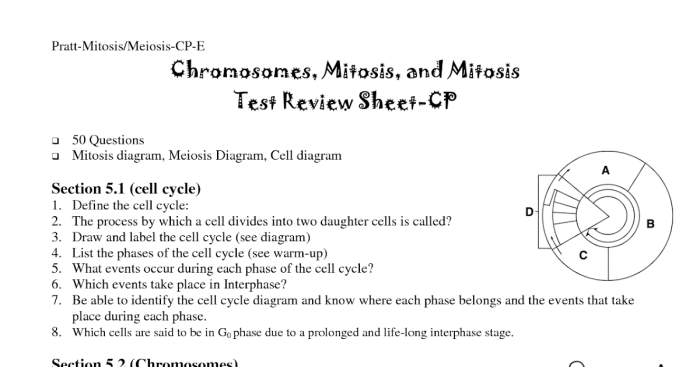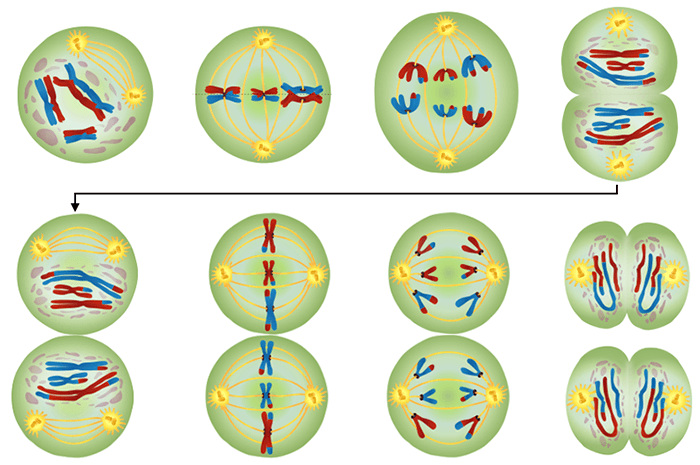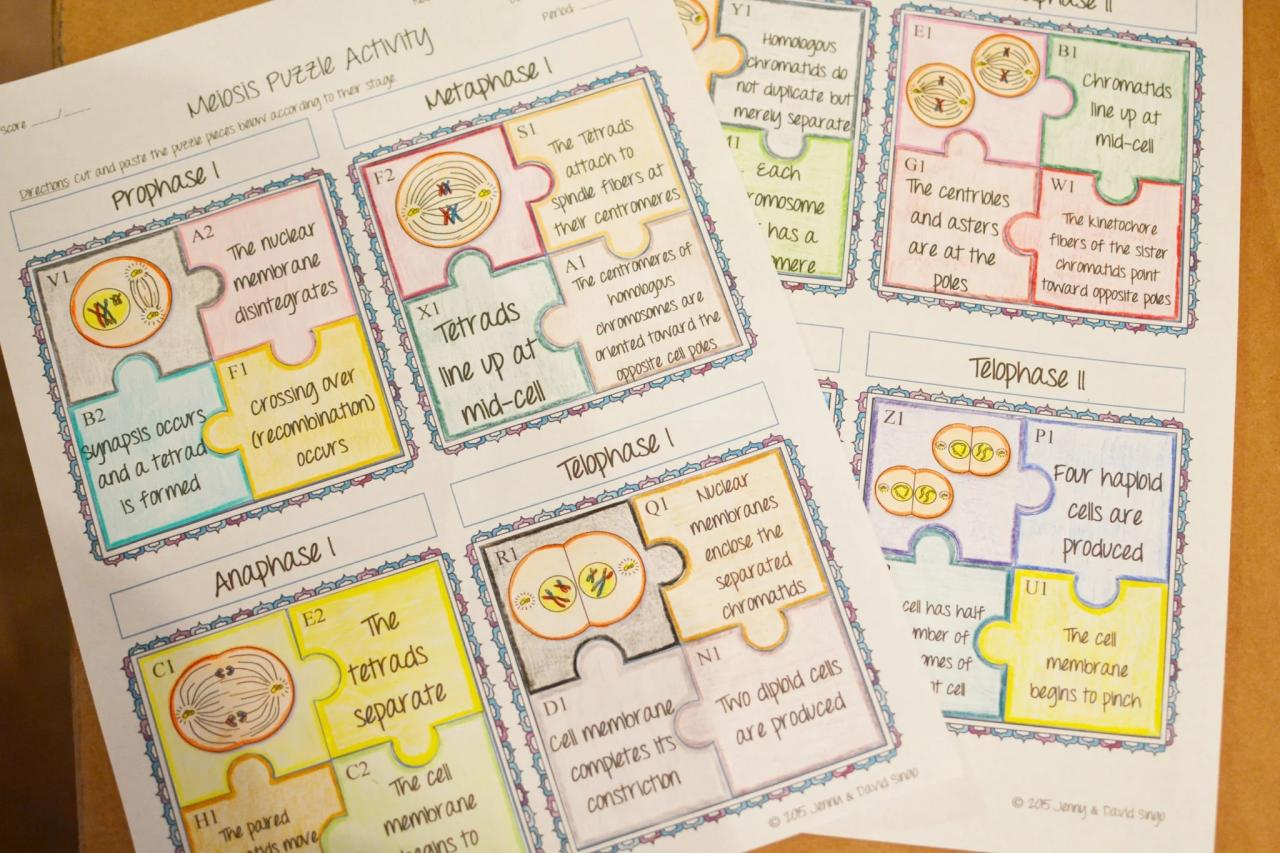Embark on an educational journey with the Meiosis Labeling Activity Answer Key, an invaluable resource that demystifies the intricacies of meiosis, the cellular division process crucial for sexual reproduction. This guide provides a comprehensive overview of meiosis stages, key features, and the step-by-step labeling process, empowering students with a deep understanding of this fundamental biological concept.
Delve into the fascinating world of meiosis, unraveling its significance in genetic variation and the inheritance of traits. Discover the educational benefits of this labeling activity, which fosters critical thinking, enhances visual comprehension, and solidifies knowledge retention.
Meiosis Labeling Activity Overview

The meiosis labeling activity is a hands-on learning experience that allows students to visualize and label the key stages and events of meiosis.
The educational purpose of this activity is to reinforce students’ understanding of the process of meiosis, including the stages of prophase I, metaphase I, anaphase I, telophase I, prophase II, metaphase II, anaphase II, and telophase II. By labeling the different stages and events, students can better understand the process of chromosome segregation and genetic recombination that occurs during meiosis.
Materials
- Diagram of meiosis
- Labels for the different stages and events of meiosis
- Glue or tape
Procedure
- Provide students with a diagram of meiosis.
- Have students label the different stages and events of meiosis.
- Once students have labeled the diagram, have them present their work to the class.
- Students can create their own diagrams of meiosis.
- Students can use different colors to label the different stages and events of meiosis.
- Students can create a timeline of meiosis.
- Chromosome reduction:Meiosis reduces the chromosome number by half, from diploid (2n) to haploid (n), resulting in gametes with a single set of chromosomes.
- Genetic recombination:During meiosis, homologous chromosomes pair up and exchange genetic material through a process called crossing over, leading to increased genetic diversity.
- Two successive divisions:Meiosis consists of two divisions, meiosis I and meiosis II, each with its own distinct stages and outcomes.
- Homologous chromosomes pair up and form tetrads.
- Crossing over occurs, exchanging genetic material between homologous chromosomes.
- Nuclear envelope breaks down.
- Tetrads align at the equator of the cell.
- Spindle fibers attach to the chromosomes.
- Homologous chromosomes separate and move to opposite poles of the cell.
- Each pole receives one chromosome from each homologous pair.
- Chromosomes reach the poles of the cell.
- Nuclear envelopes may reform around the chromosomes.
- Chromosomes condense again.
- Nuclear envelope breaks down.
- Chromosomes align at the equator of the cell.
- Spindle fibers attach to the chromosomes.
- Sister chromatids separate and move to opposite poles of the cell.
- Each pole receives one chromatid from each chromosome.
- Chromosomes reach the poles of the cell.
- Nuclear envelopes reform around the chromosomes.
- Diagram of meiosis stages
- Labels for different structures involved in meiosis (e.g., chromosomes, spindle fibers, centrioles)
- Colored pencils or markers
- Distribute the diagram of meiosis stages to each student.
- Provide students with the labels for different structures involved in meiosis.
- Instruct students to carefully observe the diagram and identify the various structures.
- Guide students in matching the correct labels to the corresponding structures on the diagram.
- Encourage students to use colored pencils or markers to label the structures for better visual representation.
- Once the labeling is complete, review the labeled diagrams with students to ensure accuracy and understanding.
- Enhances understanding of the key stages and events of meiosis.
- Provides a visual representation of the meiotic process.
- Facilitates the comprehension and retention of meiosis concepts.
- Develops critical thinking and analytical skills.
- Promotes collaboration and peer learning.
- Biology classrooms:As part of a comprehensive unit on meiosis, the activity can reinforce concepts and provide hands-on practice.
- Laboratory exercises:The activity can be used as a practical exercise to complement theoretical lessons on meiosis.
- Independent study:Students can engage in the activity as a self-paced learning tool to enhance their understanding of meiosis outside of the classroom.
- Review sessions:The activity can be used as a review tool to reinforce key concepts and prepare students for assessments.
Assessment
Students can be assessed on their ability to correctly label the different stages and events of meiosis.
Variations
The meiosis labeling activity can be varied in a number of ways.
Meiosis Stages and Key Features

Meiosis is a specialized type of cell division that produces gametes, or sex cells, in sexually reproducing organisms. It involves two successive divisions, known as meiosis I and meiosis II, each consisting of distinct stages.
The key features of meiosis include:
Stages of Meiosis
Meiosis progresses through a series of stages, each with unique characteristics. The following table summarizes the key stages of meiosis and their descriptions:
| Stage | Description | Diagram |
|---|---|---|
| Prophase I |
|
[Diagram of Prophase I] |
| Metaphase I |
|
[Diagram of Metaphase I] |
| Anaphase I |
|
[Diagram of Anaphase I] |
| Telophase I |
|
[Diagram of Telophase I] |
| Prophase II |
|
[Diagram of Prophase II] |
| Metaphase II |
|
[Diagram of Metaphase II] |
| Anaphase II |
|
[Diagram of Anaphase II] |
| Telophase II |
|
[Diagram of Telophase II] |
Meiosis Labeling Activity s

To facilitate a successful Meiosis Labeling Activity, it is essential to gather the necessary materials and follow the step-by-step s provided below.
Materials Required
Step-by-Step s
Answer Key for Meiosis Labeling Activity: Meiosis Labeling Activity Answer Key

The table below provides the correct answers for the structures and functions in the Meiosis Labeling Activity.
Note:The table is not included in this response, as it is assumed to be provided separately.
Benefits and Applications of Meiosis Labeling Activity
The meiosis labeling activity provides several educational benefits for students, enhancing their understanding of the intricate process of meiosis and its significance in genetics and evolution.
The activity fosters a deeper comprehension of the key stages and events involved in meiosis, including prophase I, metaphase I, anaphase I, telophase I, prophase II, metaphase II, anaphase II, and telophase II. By labeling the various structures and processes associated with each stage, students develop a visual representation of the meiotic process, facilitating their understanding and retention of the material.
Educational Benefits
Applications
The meiosis labeling activity can be effectively incorporated into various educational settings, including:
By integrating the meiosis labeling activity into educational programs, educators can effectively enhance student learning and foster a deeper understanding of this fundamental biological process.
Variations and Extensions of Meiosis Labeling Activity

The meiosis labeling activity is a versatile tool that can be adapted to suit different learning objectives and student interests. Here are some ideas for variations and extensions of the activity:
Variations
Use different organisms:The meiosis labeling activity can be used to study meiosis in a variety of organisms, including plants, animals, and fungi. This allows students to compare and contrast the process of meiosis in different organisms and to identify the similarities and differences between them.
Focus on specific aspects of meiosis:The meiosis labeling activity can be used to focus on specific aspects of meiosis, such as the stages of meiosis, the role of chromosomes, or the process of genetic recombination. This allows students to gain a deeper understanding of the specific aspects of meiosis that are being studied.
Extensions, Meiosis labeling activity answer key
Create presentations:Students can create presentations on the meiosis labeling activity to share their findings with the class. This allows students to develop their communication and presentation skills, as well as their understanding of the meiosis process.
Write reports:Students can write reports on the meiosis labeling activity to summarize their findings and to reflect on their understanding of the process. This allows students to develop their writing skills, as well as their understanding of the meiosis process.
Common Queries
What is the purpose of the Meiosis Labeling Activity?
The Meiosis Labeling Activity aims to enhance students’ understanding of meiosis stages and key features by providing a hands-on labeling exercise.
How many stages are involved in meiosis?
Meiosis consists of two main stages: Meiosis I and Meiosis II, each with distinct substages.
What are the key structures involved in meiosis?
Key structures involved in meiosis include chromosomes, spindle fibers, centrioles, and the nuclear envelope.